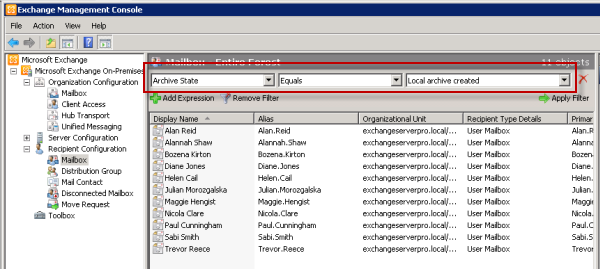In an Exchange Server 2010 environment it may be necessary to identify which mailbox users have the personal archive enabled.
This can be found easily in the Exchange Management Shell with this command.
[PS] C:\>Get-Mailbox | where {$_.ArchiveDatabase -ne $null}
Name Alias ServerName ProhibitSendQuota
---- ----- ---------- -----------------
Paul Cunningham Paul.Cunningham ex2 unlimited
Alan.Reid Alan.Reid ex2 unlimited
Alannah.Shaw Alannah.Shaw ex2 unlimited
Bozena.Kirton Bozena.Kirton ex2 unlimited
Diane.Jones Diane.Jones ex2 unlimited
Helen.Cail Helen.Cail ex2 4.688 GB (5,033,164,800 bytes)
Julian.Morozgalska Julian.Morozgalska ex2 unlimited
Maggie.Hengist Maggie.Hengist ex2 unlimited
Nicola.Clare Nicola.Clare ex2 unlimited
Sabi.Smith Sabi.Smith ex2 unlimited
Trevor.Reece Trevor.Reece ex2 unlimited
If you prefer the Exchange Management Console you can use a filter to display all of the archive enabled mailbox users.

You can also list all archive enabled users along with their archive mailbox settings.
[PS] C:\>Get-Mailbox | where {$_.ArchiveDatabase -ne $null} | ft name, archivedatabase, archivename, archivequota, archivewarningquota -AutoSize
Name ArchiveDatabase ArchiveName ArchiveQuota ArchiveWarnin
gQuota
---- --------------- ----------- ------------ -------------
Paul Cunningham Mailbox Database 01 {Online Archive - Paul Cunningham} 50 GB (53,687,091,200 bytes) 45 GB (48,...
Alan.Reid Mailbox Database 02 {Online Archive - Alan Reid} 50 GB (53,687,091,200 bytes) 45 GB (48,...
Alannah.Shaw Mailbox Database 02 {Online Archive - Alannah Shaw} 50 GB (53,687,091,200 bytes) 45 GB (48,...
Bozena.Kirton Mailbox Database 02 {Online Archive - Bozena Kirton} 50 GB (53,687,091,200 bytes) 45 GB (48,...
Diane.Jones Mailbox Database 02 {Online Archive - Diane Jones} 50 GB (53,687,091,200 bytes) 45 GB (48,...
Helen.Cail Mailbox Database 02 {Online Archive - Helen Cail} 50 GB (53,687,091,200 bytes) 45 GB (48,...
Julian.Morozgalska Mailbox Database 01 {Online Archive - Julian Morozgalska} 50 GB (53,687,091,200 bytes) 45 GB (48,...
Maggie.Hengist Mailbox Database 01 {Online Archive - Maggie Hengist} 50 GB (53,687,091,200 bytes) 45 GB (48,...
Nicola.Clare Mailbox Database 01 {Online Archive - Nicola Clare} 50 GB (53,687,091,200 bytes) 45 GB (48,...
Sabi.Smith Mailbox Database 01 {Online Archive - Sabi Smith} 50 GB (53,687,091,200 bytes) 45 GB (48,...
Trevor.Reece Mailbox Database 01 {Online Archive - Trevor Reece} 50 GB (53,687,091,200 bytes) 45 GB (48,...



Comments for this blog post are now closed; please contact team@practical365.com for any additional questions and comments, thank you.
I figured it out with this command.
Get-RemoteMailbox -ResultSize Unlimited | ?{$_.RemoteRecipientType -eq ‘ProvisionArchive, Migrated’} | ft -AutoSize -Wrap
In a Exchange 2013 Hybrid mode and trying to get a list of all users with Online Archive enabled. So far I have this command for EMS.
Get-RemoteMailbox | Format-list name,RemoteRecipientType | ProvisionArchive
But it is not working.
Thanks.
That doesn’t look like valid PowerShell syntax to me. Once you’ve used Format-List (or any Format-*) you can’t pipe to other cmdlets.
Very helpful indeed! Anyways, trying to do some Export-CSV stuffs and I’m receiving this kind of result for my archivename: Microsoft.Exchange.Data.MultiValuedProperty`1[System.String]. Any scripts on how I can break this?
Hi
Thank you for this post and your help. I was wondering if there is a shell command that identifies all users with full mailboxes. So in other words, they can no longer receive new email unless they free space in their inbox’s.
Thank you
For Exchange 2010, the Get-MailboxStatistics cmdlet will return a “StorageLimitStatus” attribute that will indicate whether they are above or below the storage quotas for their mailbox.
How to get the list for the users in particular OU ?
Try this:
Get-mailbox -OrganizationalUnit “OU=YourOU,DC=YourDomain,DC=com” -ResultSize Unlimited | where {$_.archivedatabase -ne $null}
Pingback: Exchange 2010 Archiving
Great writeup but I’m having an issue exporting to csv?
Get-Mailbox -ResultSize unlimited | where {$_.ArchiveDatabase -ne $null} |ft name,archivedatabase | Export-Csv C:TempArchiveExport.csv -NoTypeInformation
I figured it out. The key was to use “select-object” and not format-table or format-list
Thanks for the awesome article! Really helped me out!
you could start a mailboxexport request for the mailbox.
Then you could do another mailbox export request for the archive to be written into the PST of the mailbox.
After all this you could turn around to process with a mailbox import request of the PST (merged mailbox & archive)
What would be the command to export the archive mail from the archive mailbox back into the users active mailbox or how would you do this manually?
jm,
Those are active text boxes, so you can copy the commands.
From first box copied just now:
Get-Mailbox | where {$_.ArchiveDatabase -ne $null}
Thanks,
Wes
Hi,
Thanks interesting. You might want to add the command elsewhere than just in a screenshot.
I mean, it would be useful to be able to copy it right? 🙂
What do you mean?
I think the comment above is just asking that the command is in the post so it can easily be copied (instead of it just in the screen clip). Something like: Get-Mailbox -ResultSize unlimited | where {$_.archivedatabase -ne $null}
Helpful article, thanks.
Those aren’t screenshots. The commands can already be copied as text in the post.
Pingback: Exchange Server 2010: находим все почтовые ящики с включенным архивом | ИТология